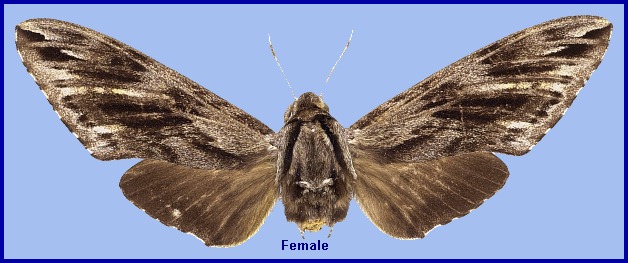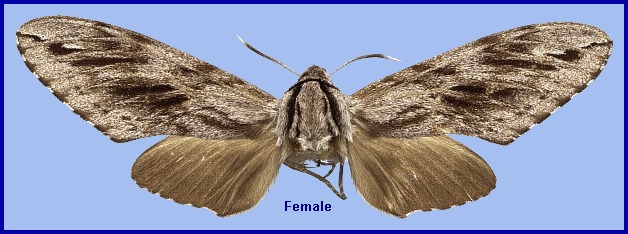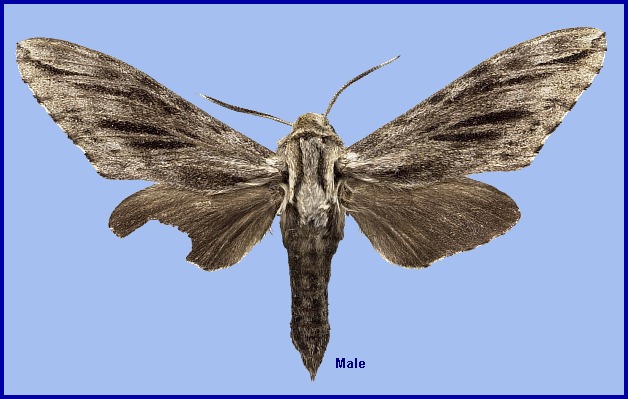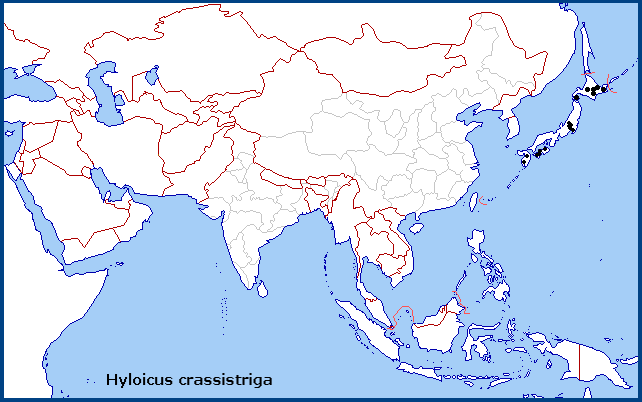


Hyloicus crassistriga Rothschild & Jordan, 1903, Novit. zool. 9 (suppl.): 119 (key), 145. Type locality: Japan.
Synonym. Sphinx crassistriga (Rothschild & Jordan, 1903).
Synonym. Sphinx crassistriga aino Kishida, 1990, Gekkan-Mushi 231: 10. Type locality: Japan: Hokkaido, Shari-gun, Koshi-mizu-cho. Synonymized with the nominotypical subspecies by Zolotuhin & Yevdoshenko (2019), Hawkmoths of Russia and adjacent territories: 124, 438.
[Further details on this species in Japan, as well as photos of many stages, can be found on Digital Moths of Japan.]
Antenna thickened distally, with a large brown patch over the greater part of the dorsal surface. Body upperside pale brown, palest laterally; a black oblique line on each side runs obliquely from the antennal base to the collar; the edge of the collar and upper edge of mesothoracic tegula broadly black, especially the tegula. Abdomen upperside with a black mesial line and black lateral patches. Proboscis short and weak. Palpus slender, rough-haired; first segment pale. Fore- and midtibiae with very few spines apically. Paronychium without lobes.
Forewing upperside wood brown with brownish black markings: two very oblique antemedian costal lines crossing the apex of the discal cell, followed a short streak in the cell, and continued from vein Cu2 to the inner margin, which they reach about 5mm. from the base, to which they are connected by a streak, the space between the lines black posteriorly; two heavy discal streaks posterior to veins M3 and Cu1, the anterior one the longer, but less differentiated from the background than in Hyloicus crassistriga aino; a third streak from vein M1 to M2 more oblique; the discal lines crossed by these streaks not prominent, being represented by blackish brown patches, but becoming clearer beyond vein Cu2; a heavy oblique apical line; some small submarginal spots; the fringe brownish black with white dots. Hindwing upperside brown, paler towards base, fringe spotted with white. Hindwing underside with two vestigial distal bands. Underside of both wings somewhat greyish brown. Forewing underside with a vestigial discal band nearer the distal margin than the discal cell; a thin apical line present.
In the female genitalia, ostial plate similar to that of Sphinx ligustri Linnaeus. Ostium proximal, a small folded ridge proximal to it, continued on both sides to the apex of the plate as a longitudinal fold.
Individuals from Hokkaido are generally smaller, with the forewing upperside tinged with bluish grey, and the two black streaks posterior to veins M3 and Cu1 narrower but more conspicuous.
Japan: 11.iv (Hokkaido); 15.v (Hokkaido (Shari-gun)); 16.v-21.viii (Honshu); 1.vi-1.viii (Shikoku); 14.vi-31.vii (Hokkaido); 19.viii (Kyushu).
Although most adults have been caught between mid July and mid August, the presence of individuals from mid May to early June indicate two generations per year (Masui, 2012).
OVUM:
LARVA: 60mm. In the final instar similar to the green form of Hyloicus pinastri, but more robust and lacking the fine, dark, encircling segmental lines. Laterally apple-green with fine yellow spotting. On each side, a broken, brilliant white, dorso-lateral band runs from the head to the final segment, and there is a similar ventro-lateral band. A broader, reddish-brown dorsal band is present, also running from the head to the final segment (Masui, 2012). This is bordered on either side by another broken, brilliant white (upper) dorso-lateral band. The dark reddish-brown, granular horn is situated within the dark dorsal band. Head oval, beige, with two vertical, mid-brown/orange-yellow cheek stripes and two dark-brown face stripes. Anal flap and terminal claspers reddish-brown. Spiracles dull orange.
PUPA: 30--40mm. Very similar to that of Hyloicus pinastri, except that the free tongue-case is replaced by a small, blunt knob.
Larval hostplants. Larvae have been found on pines (Pinus sp.), but there are also records from Larix and Abies (Masui, 2012), particularly Abies firma (Nakajima, 2013).
Japan: HOKKAIDO (Shari-gun (Koshi-mizu-cho; Miwa-cho); Nukabira Tokachi; Tokachi; Sorachi, Yamabe village; Chitose; Fujishiro; Nari-gawa). HONSHU (Fukushima Pref. (Karuizawa (Kishida, 1984)); Gunma Pref. (Mt. Tanigawa, 600m; Mt. Haruna; Ikaho; Minakami-machi, 600m); Tokyo Pref. (Mt. Takao); Nagano Pref. (Kitasaku-gun); Yamanashi Pref. (Otsuki, 700m); Chiba Pref. (Kimitsu); Saitama Pref. (Chichibu-gun)); SHIKOKU (Ehime Pref. (Kamiukena County, 1100m); Kagawa Pref. (Takamatsu, 400m); Kochi Pref. (Nagaoka-gun, 600-900m; Sukumo, 800m; Ino)); KYUSHU (Kagoshima Pref. (Kirishima); Miyazaki Pref. (Shiiba, 900m)).
Endemic to the mountains of Hokkaido, Honshu, Shikoku and Kyushu, Japan (Masui, 2012).

 Return to Sphingidae of the Eastern Palaearctic species list
Return to Sphingidae of the Eastern Palaearctic species list